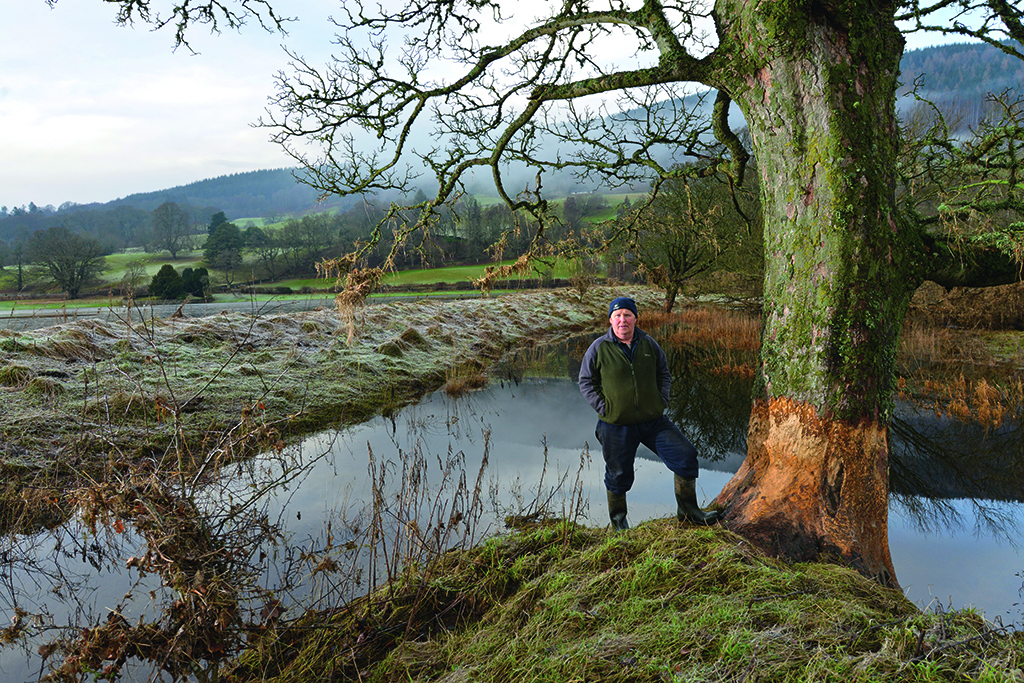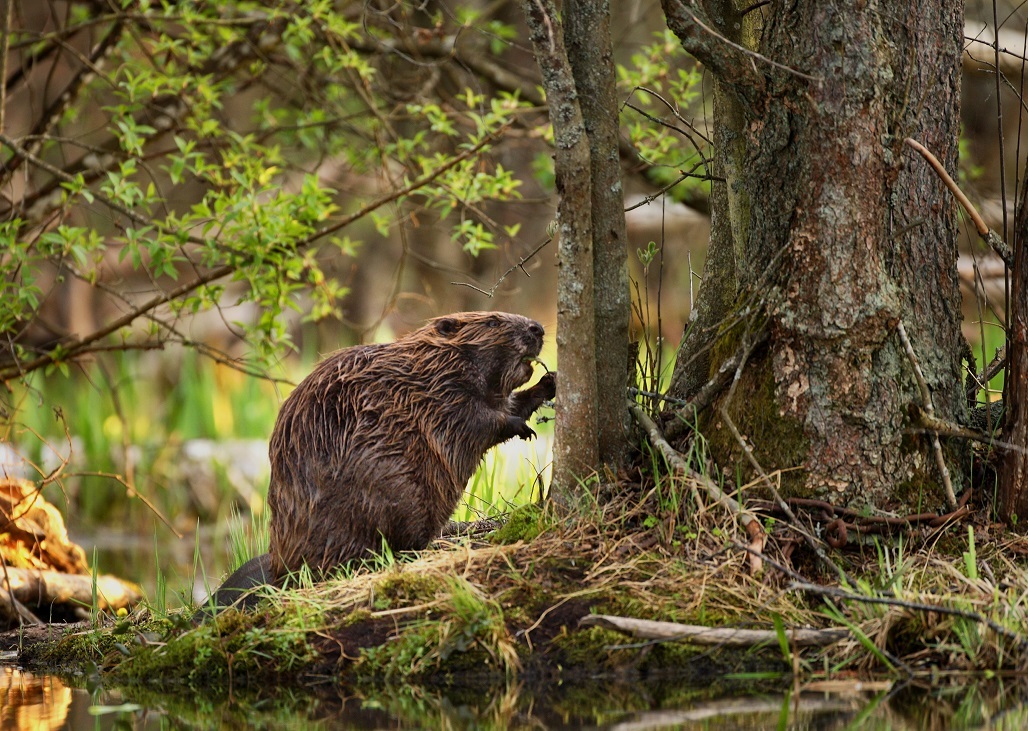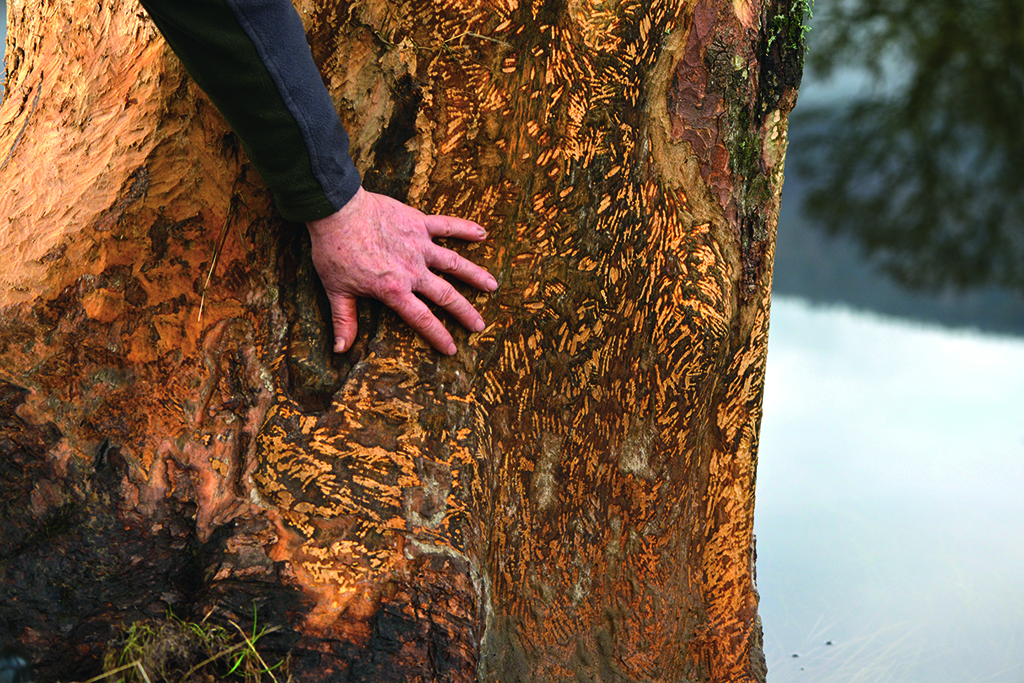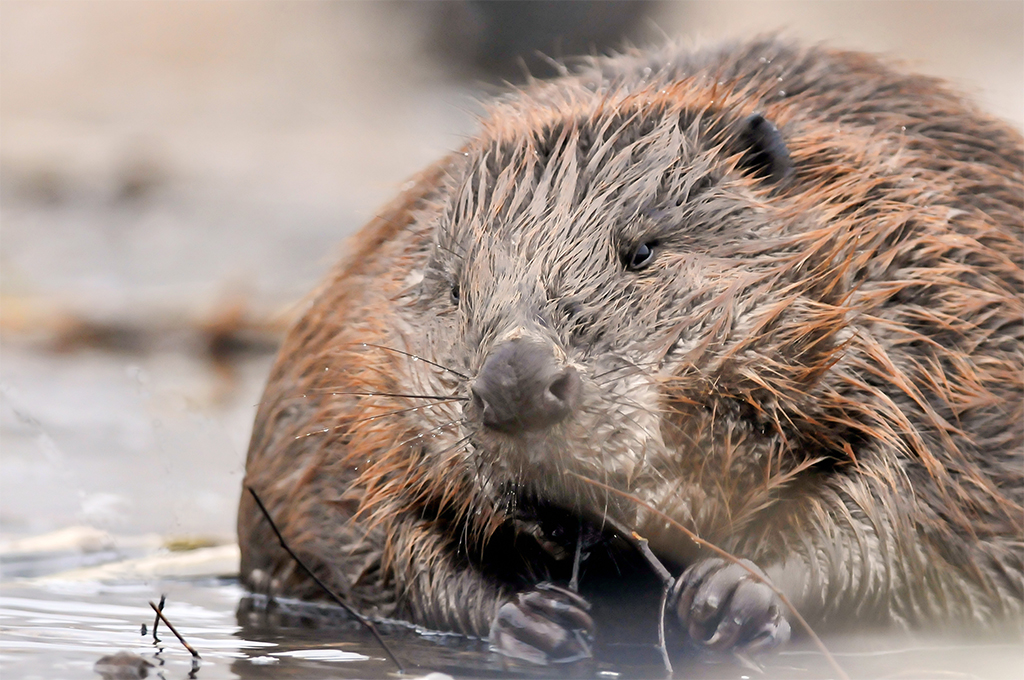
Tales of the riverbank as beavers pose a problem
As beavers continue their rapid colonisation of Tayside, Strathearn and Strathmore, seeping their way effortlessly into river systems, there is growing disenchantment amongst the farming fraternity, and mounting worries about how to deal with the issues arising daily.
Whilst on the one hand, conservationists and many members of the public are ecstatic about the beaver’s return, arguments and tensions mount between two sides with widely differing agendas. Some farmers are apoplectic damning the beaver with wrath and venom as tempestuous as our recent storms. And some unlucky gardeners are furious to find trees felled and ancient orchards ruined almost overnight. So what is the farmers’ story?
Roddy Kennedy, a National Farmer’s Union director for East Central Scotland has worked the land in the Tay flood plain close to Aberfeldy all his life. Well-used to dealing with rising water most seasons since he took over the family farm, he first noticed beaver damage to trees and saplings five or six years ago.
‘I am skeptical about the beaver and frankly we don’t want it. From our point of view, I was not so worried about the saplings being removed but began to have concerns that the newly established beavers would start burrowing into riverbanks and undermining them. We have had no major damage yet but we have cleared many of their felled trees from out of the river. We will have to do more soon as there is now a significant burrow stretching from the river bank into the flood-bank, and if we do not tackle this we will have a major breach, and this will prove disastrous’.

Roddy Kennedy, with beaver damage to a tree in Aberfeldy
We wander along the riverbank on a dour grey day soon after floods have caused more misery throughout Scotland. Evidence is everywhere with gates and fences still hidden under feet of water; a tidemark of torn vegetation, silage wrap, trees, sodden bales, and general detritus carried by raging water. Bright yellow-orange patches on trees everywhere reveal fresh tooth marks. Beavers have been busy gnawing previously inaccessible wood easily reached on rising water levels. A stand of stunning mature sycamores has also been tackled – all are ring-barked.
‘I am most upset to see this’ says Roddy, ‘It has only just happened, but just look at the size of those trees. It’s incredible what the beaver can do. You really have to admire its tenacity. They will now have to be felled if the beavers don’t get there first. They have ruined them. When they fall they will undermine the riverbank and cause further erosion. No, I am not at all happy’.
On copious other smaller drainage ditches and burns running into the Tay, irate, frustrated farmers have been demolishing dams with JCBs and clear-felling riparian fringes, sawing trunks to ground level and ripping out mature trees, leaving a wasteland in the hope of deterring the eager beaver. It has caused upset to the general public and conservationists who feel there will be ecological repercussions from such savage, shortsighted actions.
‘What do you feel about these drastic measures?’ I ask Roddy. ‘Don’t you think that doing this is going to have a dreadful impact on the entire local ecosystem?’
‘I would much rather trees and saplings were left as they are not only aesthetically attractive but they also help hold the riverbanks in extreme flood conditions. I agree that it is an important habitat for small birds, and probably even more insects too. I don’t want to have to do this, but I can see we may have no option. If this helps deter the little buggers then that is what we will be forced to do.

Beavers are flourishing in Scotland since their reintroduction
‘We have not incurred huge costs so far, probably just a few days with a couple of men and machines, but flood-bank repair is impossible to estimate. If it can be done before any severe damage occurs, It’ll probably cost us around £2500 but during the winter months it’s so difficult to reach the areas where damage is occurring; if it gets really bad our bill could easily mount to £10,000. To remove any mature trees could incur costs of up to £1000 per tree’.
‘It sounds as though you would like to see an end to all beavers, do you feel that the farming community cannot cope with them’, I ask Roddy. He shrugs and grimaces. ‘I see great difficulty with beavers in prime farming areas, where significant drainage work has been done over the last two centuries, whether it has been with ditching, or as in our case ancient flood-banks that have always worked well. Beavers are totally incompatible with farming, and the two cannot co-exist.’
I suggest the idea of mitigation with specialist beaver officers where in extreme cases beavers could be live trapped and relocated, or even on rare occasions culled.
‘Frankly, I don’t think this would work – it would involve a new set of rules and setting it up would be prohibitive and would create as many problems as it would solve. Flow devices and financial help in less intensive areas might help but certainly not on good land such as in the Tay catchment area where the situation is already out of hand. I cannot see a single benefit to having beavers. If the government decides the beaver should stay, then they should leave things as they are now and certainly not give them protected status. As we do with deer, rabbits, or mink, we should be allowed to control them otherwise it will prove disastrous’.
Roddy Kennedy is equally vehement on his views about the possibilities of other re-introduced species. ‘The sea eagle was different; there was an agreed re-introduction. We can argue about the current numbers, the predation of lambs, the effect on the golden eagle population, but it was done on an agreed timetable. The beaver introduction was not legal in our area. Any other species must go through a rigorous consultation but the people it will affect most should have a weighted opinion when it’s their livelihoods that are at stake. I think the idea of lynx is ridiculous and I know most farmers do. As for wild boar elsewhere there are huge problems with the damage caused by boar that have naturalised illegally. Really we have gone too far to bring these things back – it will affect people’s livelihoods’.
In the Strathmore Valley, Adrian Ivory has become accustomed to having to deal with beaver issues. ‘Problems for us have been increasing annually over the past three years. Beaver dams were causing water to back-up for long distances. This then had a major impact on the drains – we started asking if the drains were broken as water was not disappearing properly off the fields. They were already full to capacity from the water in the burns due to beaver dams preventing flow.

Roddy Kennedy looks at beaver marks on a tree
‘It’s a serious problem and I don’t want to be pushed into clearing all the riverbank to deter them due to the negative impact on the environment and other species. However, if beavers are protected we may be forced down this route as we are constantly spending money on removing dams and it could save thousands of pounds if it was done in one, costing us less overall. I would hope they would then move elsewhere. We have had a lot of problems including crop damage, tree damage, drainage issues, dams, collapsing riverbanks, to say nothing of the huge amount of time it takes to sort out.
‘Beavers are going into crops of wheat and using it to aid dam building, it’s not having a major impact yet but it is a sign of what could happen in the future. Many drains run at a fall of 1 in a 1,000, therefore every 5ft of beaver dam over 1 mile of farmland drains, means the drains become totally ineffective, thus ruining some of the best arable land in Scotland.
‘We need to hire a digger and then spend time removing the debris that has been left behind. When their dams are built with the aim of stopping a burn’s flow water tries to find a way around and undermines burn and riverbanks leading to the collapse of flood defenses which in turn leads to further flooding. The pro-beaver lobby talks of dams filtering out pollution, but in our circumstances the diffuse pollution being generated is considerable. Allowing beavers in productive arable areas will cause and increase diffuse pollution due to blocked drains meaning waterlogged land and increased surface water run-off. The amount of time and effort that I have to put into something which I have no say over is considerable – I am trying to produce quality food but find myself walking the water courses for hours every week to check there are no new dams, and to see where the latest beaver felled trees are, or to warn staff against going near certain areas with machinery as the banks are unstable and unsafe.
‘The physical cost of hiring people in with diggers and putting staff on to debris clearance is currently around £4,000 a year, but mounting all the time especially as beaver numbers are rising fast – this does not account for the time spent walking rivers and burns or clearing dams manually. The actual cost is far greater than this’.
Unlike Roddy Kennedy, Adrian thinks that there is certainly a place for beavers. ‘I am sure in the right areas they could provide a tourist opportunity – this correct place though is not where farmers are trying to produce food for the nation. Scottish Natural Heritage, Scottish Wildlife Trust, and the Scottish Government spent millions of pounds and had hours of discussion about the best place to reintroduce beavers, and although their first choice was rejected by the tree owners they all agreed on Knapdale in the west, not Tayside or Angus where these beavers have come into existence without any license – essentially they are illegal/alien species.

Beavers are causing problems for Scottish farming
‘If we as farmers break the law there is a consequence for our actions normally leading to a large fine, or in animal welfare issues a ban on keeping livestock, or even jail. From a farmer’s viewpoint those who are responsible for this have not been penalised or banned from keeping such creatures having breached their license. They are now saying the animals should be protected whilst farmers are forced to pick-up the financial cost of dealing with the considerable damage. Having no guidance or advice on how to cope with all this makes life hard to start with. Currently there are two hugely opposing sides views and that is not helpful to anyone.
‘I would rather see the government making a carefully considered correct decision about the beaver’s status here, rather than rushing into the wrong decision due to pressure from lobbying groups – rushed decisions tend to lead to poor decisions, resulting in years of unintended consequences.
‘Trapping problem animals and mitigation will be very hard. We have tried to live trap them here in conjunction with Edinburgh Zoo but none were caught over many months – the question to be asked is who would pay for specialist officers, and would they have a balanced view? They would need to have a very good understanding of agriculture so that they understood the farmers’ viewpoint.
‘As for flow devices I am not sure they would help, and who would cover the costs? As a farmer I cannot see any positive benefits to having beavers in our area. Both sides of the argument have to be prepared to give a little and work with the minister to come up with a workable solution that is both acceptable politically, and for both parties. Currently the situation is getting out of hand especially with two sides having such differing viewpoints.
‘Farmers need to be allowed to produce quality produce as efficiently as possible so they can sell on to the public as affordably as possible – this means they need as few obstacles in their way. There is precedence given to the zoning approach in other EU and non-EU countries such as Norway, the Netherlands, and Germany where beavers are encouraged on relatively unproductive higher ground but removed and culled from low-lying productive areas. We currently know of no country in the world that gives the beaver full protection in low-lying productive arable areas. For me the best way forward would be sensible zoning.
‘Reintroduction of species is not straightforward – things have changed. When beavers were here some 400 years ago, what would the population of Tayside and Strathmore have actually been, and what sort of farming was taking place? The key is surely found in the balance of nature – the unintended consequences need to be considered very carefully – wild boar are causing havoc in this area and costing people money and crop losses. The beaver is now here but has no natural predators. There are no wolves or bears, nor any other natural predators to control the balance of nature, but could we cope with such animals the lynx included? In Argentina 30 beavers were introduced and now due to lack of predators number 250,000. In Australia rabbits were introduced and became rampant, foxes were then introduced to control the rabbits and became a bigger problem than the rabbits. Everything is good when done in balance with consideration given to what is already here.’
TAGS

